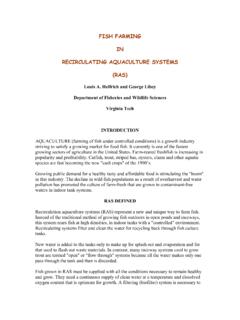Transcription of Wastewater Technology Fact Sheet: Trickling Filters
1 United StatesEnvironmental ProtectionAgencyOffice of WaterWashington, 832-F-00-014 September 2000 WastewaterTechnology Fact SheetTrickling FiltersDESCRIPTIONT rickling Filters (TFs) are used to remove organicmatter from Wastewater . The TF is an aerobictreatment system that utilizes microorganismsattached to a medium to remove organic matterfrom Wastewater . This type of system is commonto a number of technologies such as rotatingbiological contactors and packed bed reactors (bio-towers). These systems are known asattached-growth processes. In contrast, systems inwhich microorganisms are sustained in a liquid areknown as suspended-growth TFs enable organic material in the Wastewater to beadsorbed by a population of microorganisms(aerobic, anaerobic, and facultative bacteria; fungi;algae; and protozoa) attached to the medium as abiological film or slime layer (approximately mm thick).
2 As the Wastewater flows over themedium, microorganisms already in the watergradually attach themselves to the rock, slag, orplastic surface and form a film. The organicmaterial is then degraded by the aerobicmicroorganisms in the outer part of the slime the layer thickens through microbial growth,oxygen cannot penetrate the medium face, andanaerobic organisms develop. As the biologicalfilm continues to grow, the microorganisms nearthe surface lose their ability to cling to the medium,and a portion of the slime layer falls off the process is known as sloughing.
3 The sloughedsolids are picked up by the underdrain system andtransported to a clarifier for removal from AND DISADVANTAGESSome advantages and disadvantages of TFs arelisted , reliable, biological in areas where large tracts of landare not available for land intensive qualify for equivalent secondarydischarge in treating high concentrations oforganics depending on the type of for small- to reduce soluble BOD5 in nitrification process power level of skill and technicalexpertise needed to manage and operate treatment may be needed to meetmore stringent discharge accumulation of excess biomass thatcannot retain an aerobic condition and canimpair TF performance (maximum biomassthickness is controlled by)
4 Hydraulic dosagerate, type of media, type of organic matter,temperature and nature of the biologicalgrowth).CRequires regular operator of clogging is relatively low loadings depending on and control are limited incomparison with activated-sludge and odor CRITERIAA TF consists of permeable medium made of a bedof rock, slag, or plastic over which Wastewater isdistributed to trickle through, as shown in Figure or slag beds can be up to meters (200feet) in diameter and meters (3 to 8 feet)deep with rock size varying from cm (1 to4 inches). Most rock media provide approximately149 m2/m3 (15 sq ft/cu ft) of surface area and lessthan 40 percent void space.
5 Packed plastic Filters (bio-towers), on the other hand, are smaller indiameter (6 to 12 meters (20 to 40 feet)) and rangein depth from to meters (14 to 40 feet).These Filters look more like towers, with the mediain various configurations ( , vertical flow, crossflow, or various random packings). Research hasshown that cross-flow media may offer better flowdistribution than other media, especially at loworganic loads. When comparing vertical mediawith the 60 degree cross-flow media, the verticalmedia provide a nearly equal distribution ofwastewater minimizing potential plugging at higherorganic loads better than cross flow media.
6 Theplastic medium also required additional provisions,including ultraviolet protective additives on the toplayer of the plastic medium filter, and increasedplastic wall thickness for medium packs that areinstalled in the lower section of the filter whereloads design of a TF system for Wastewater alsoincludes a distribution system. Rotary hydraulicdistribution is usually standard for this process, butfixed nozzle distributors are also being used insquare or rectangular reactors. Overall, fixednozzle distributors are being limited to smallfacilities and package plants.
7 Recently somedistributors have been equipped with motorizedunits to control their speed. Distributors can be setup to be mechanically driven at all times or duringstalled addition, a TF has an underdrain system thatcollects the filtrate and solids, and also serves as asource of air for the microorganisms on the treated Wastewater and solids are piped to aSource: Metcalf & Eddy, Inc. and Tchobonaglous, 1 TYPICAL Trickling FILTER settling tank where the solids are , part of the liquid from the settling chamberis recirculated to improve wetting and flushing ofthe filter medium, optimizing the process andincreasing the removal is essential that sufficient air be available for thesuccessful operation of the TF.
8 It has been foundthat to supply air to the system, natural draft andwind forces are usually sufficient if large enoughventilation ports are provided at the bottom of thefilter and the medium has enough void following four basic categories of filter designare based on the organic loading of the filtersLow-rate Filters are commonly used for loadings ofless than 40 kilograms five day biochemical oxygendemand (BOD5)/100 meters cubed per day (25 lbBOD5/1000cu ft/day). These systems have fewerproblems than other Filters with regards to filterflies, odors, and medium plugging because of thelower loading rate.
9 Low-rate Filters with a rockmedium range in depth from to meters (3-8 ft.). Most low-rate Filters are circular with rotarydistributors, but some Filters currently in use arerectangular. Both of these configurations areequipped with dosing syphons or periodic pumps toprovide a high wetting rate for short intervalsbetween rest periods. A minimum wetting rate liters per square meter-second ( gal/sqft/min) is maintained to prevent the high rate plasticfilter medium from drying out. With a rockmedium, the Filters tend not to be hydraulicallylimited and have application limits ranging to liters per square meter-second ( gal/sq ft/min).
10 The sloughed solids from a low-rate filter aregenerally well-digested and as a result these filtersyield less solids than higher rate Filters . Secondaryquality effluent is readily achievable if the low-ratetrickling filter design incorporates filter media withbioflocculation capabilities or good filtersIntermediate rate Filters can be loaded up to 64 kgBOD5/100 m3-d (40 lb BOD5/1000cu ft/day). Inorder to ensure good distribution and thoroughblending of the filter and secondary effluent, thesystem should recirculate the Trickling filtereffluent. The biological solids that slough from anintermediate Trickling filter are not as well digestedas those using a low-rate filter.














